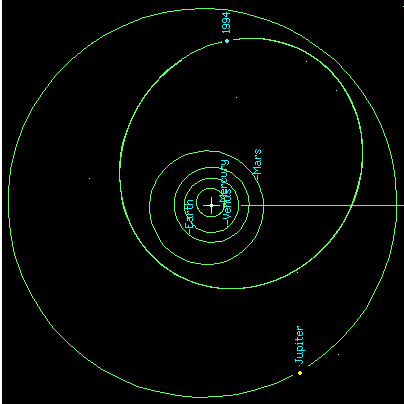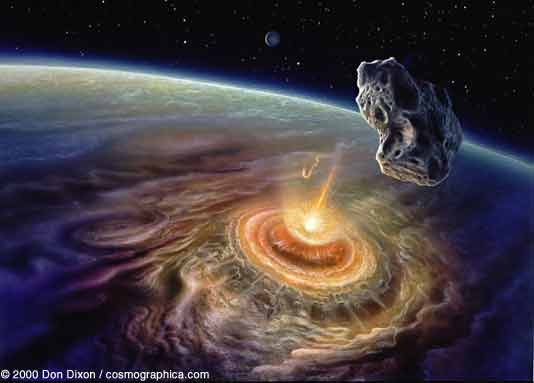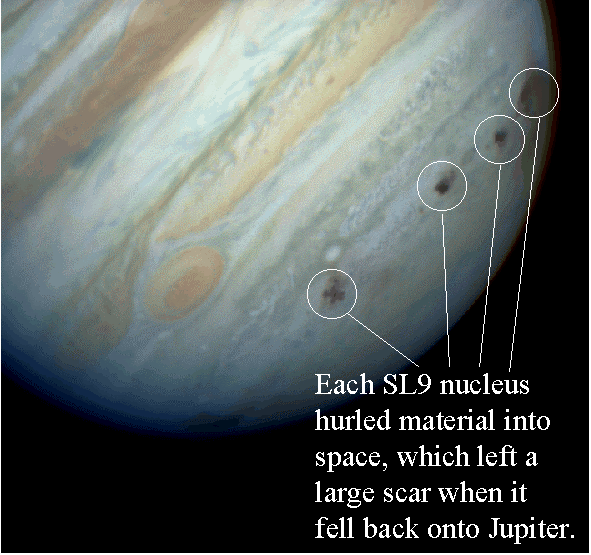Mass Extinctions - Interruptions in the
Orderly Process of Evolution
Key points: Chaotic asteroid orbits and
ongoing bombardment of the planets; the K/T extinction; other extinctions
Chaos and Asteroid Bombardment
Despite the 4.6 billion years for the earth to
clear out all asteroids it might collide with, collisions are still frequent.With
thousands of members, the solar system is so complex that chaotic orbits can propel
asteroids into the inner solar system.
 |
This comet (blue) is on an orbit that takes it back and forth between
Jupiter (yellow) and Mars. We show just 50 years of its motion. Every time it comes close
to Jupiter it is perturbed into a new orbit, and eventually it is likely to collide with
Mars. (animation by M. & G. Rieke, from Dance of the Planets) Even
though the comet has gone through many orbits, its behavior is difficult to predict
accurately because of the large effects from Jupiter. Chaos
applies to a system where virtually unmeasurable changes can lead to completely different
final results. The comet is on a chaotic orbit. |
The processes that can deflect the orbits of
comets or asteroids lead to the possibility that Earth could collide with a significant
sized object.
The Shoemaker-Levy Comet Impact with Jupiter gave
us a way to test theories of extinction by asteroid impact.
 |
| In the spring of 1993, a very curious comet was discovered.
This comet was not single, but a string of cometary pieces strung out in a line.
Running the orbits backwards showed that these pieces most likely came from a parent body
which fell apart in 1992 when it passed very close to Jupiter. (from
Astronomy Picture of the Day, NASA/HST/H. Weaver, T. Smith http://antwrp.gsfc.nasa.gov/apod/ap970323.html) |
Further calculations showed that the pieces would hit Jupiter in July of
1994. Astronomers around the world prepared to observe the crash.
 |
The orbit of the comet took it close to both
Jupiter and Saturn, so it had been in a chaotic situation similar
to the comet illustrated previously between Mars and Jupiter. |
 |
The impacts occurred on the far side of Jupiter. Here are two artist's concepts of
how they might have looked
|
 |
Implications for Collisions with the earth
 |
The events on
Jupiter agreed closely with the most popular theory for the extinction of the dinosaurs.
In this theory, a dramatic impact on the Yucatan coast of a comet or asteroid about 10 km
in diameter 65 million years ago caused havoc with life on Earth. The time of this extinction is called the
"Cretaceous-Tertiary" (also called K/T) Boundary.
A series of paintings by William Hartmann shows how it might have looked from a
"safe" distance.
|
 |
 |
 |
Disaster strikes!
From David Hardy, http://www.hardyart.demon.co.uk/html/main.html Although
most dinosaurs were probably killed off in the initial event where returning impact debris
superheated the upper atmosphere, the afterevents would have been very destructive too.
There would have been huge tidal waves from the shock, and possibly the impact triggered
large earthquakes that caused even more. Afterwards, the upper atmosphere would have been
saturated with the soot and gases from the massive fires, resulting in years of climate
change that included severe acid rain. Here is another version of the events.  (from L. Close, http://athene.as.arizona.edu/~lclose/teaching/a202/lect7.html) (from L. Close, http://athene.as.arizona.edu/~lclose/teaching/a202/lect7.html)
|
However, there are also a number of variations on the theory
 |
| "When the dust finally settled the mammals found a world in which
most vertebrates larger than themselves were dead; the meek had inherited the earth."
- John Allman, "Evolving Brains," 2000 |
In any case, the elimination of the dinosaurs left the evolutionary field
open for mammals  The reconstruction to the left shows primitive mammals in a scene just after the K/T
extinction (from http://www.palaeos.com/Cenozoic/Paleocene/Paleocene.htm)
The reconstruction to the left shows primitive mammals in a scene just after the K/T
extinction (from http://www.palaeos.com/Cenozoic/Paleocene/Paleocene.htm)
Read more about them  |
There have been a number of mass extinctions previous to the K/T
event.
 |
The major extinctions are indicated to the left by peaks in the rate
of disappearance of biological "families" of plant and animal types. The
Permian-Triassic event appears to coincide with a huge volcanic event in Siberia that
produced a flow of lava covering 600,000 square miles. It is likely that the gas and dust
from these eruptions produced a climate catastrophe. There may have also been an asteroid
impact at about the same time to make things worse. Ironically, this extinction cleared
away other animal forms and gave the dinosaurs the opening that allowed them to rule the
earth for 200 million years. The cause of many of the other extinctions is not clearly
understood. They might be related to impacts, to other astronomical events like nearby
supernovae, or to geological events that resulted in large-scale climate change, such as
volcano eruptions  . .http://www.enchantedlearning.com/subjects/dinosaurs/extinction/ |
How safe are we from another extinction that might include us
Read more at:
http://liftoff.msfc.nasa.gov/Academy/SPACE/SolarSystem/Meteors/Craters.html
http://nicholnl.wcp.muohio.edu/DingosBreakfastClub/Extinction/Extinct1.html
Test your understanding before going on

Diorama of early complex life (Ediacaran), from Smithsonian |

|
 |
Click to return to syllabus |
| Click to return to Advanced Life |
hypertext  G. H. Rieke G. H. Rieke |
Click to go to Emergence of Intelligence
|


 What if a large comet or asteroid
hits......
What if a large comet or asteroid
hits......


















